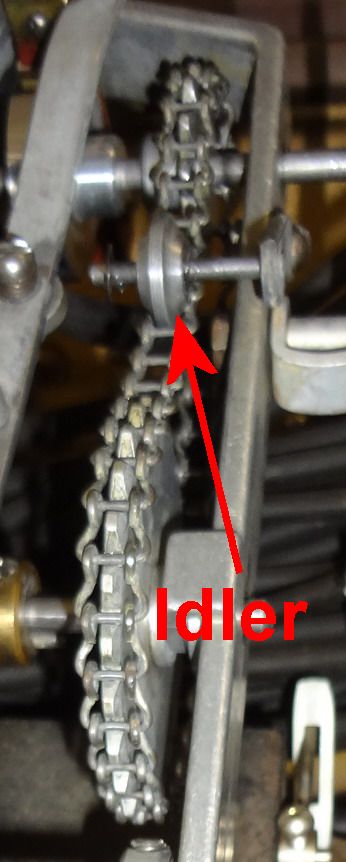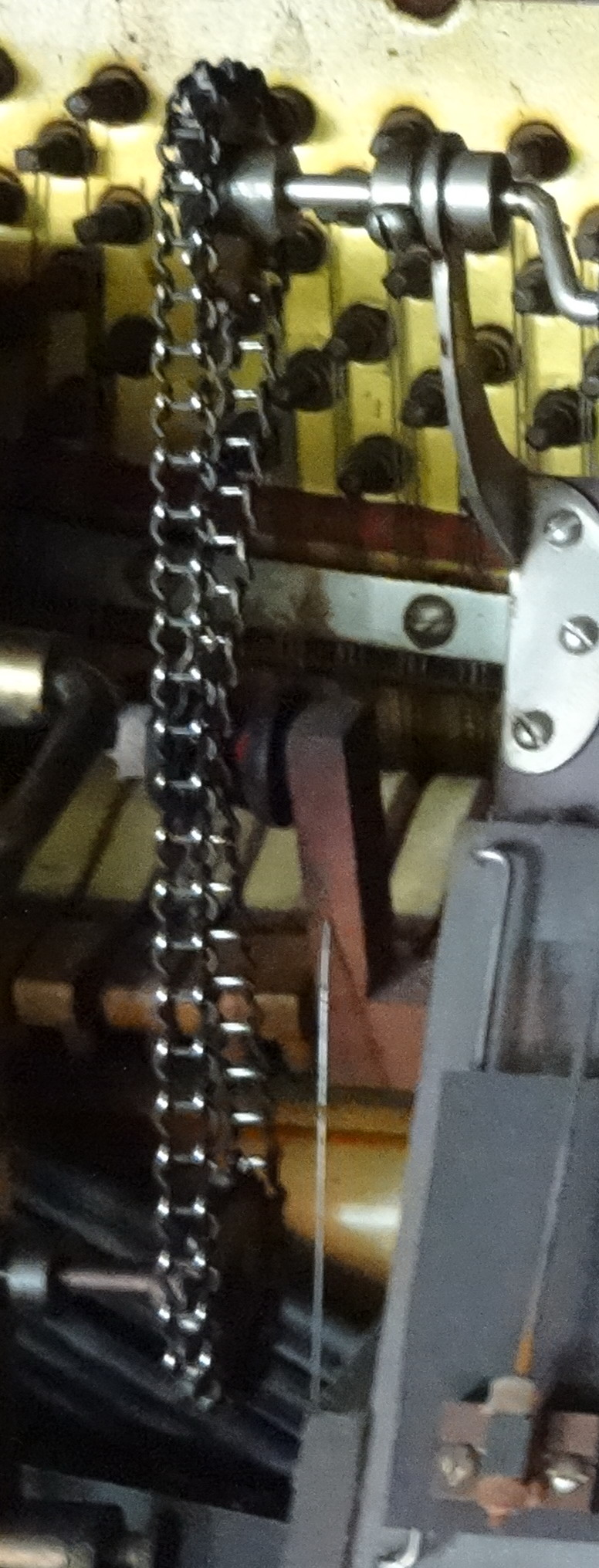
|

|

|

|

|

|
| Home | Manuals | Supplies | Search | Consult | Contact | Testing | Service |
|
A question was posed to me concerning the purpose and adjustment of the chain idlers (or chain tensioners) in a player piano. Typically, there are two idlers. Generally, the one for the air motor is spring loaded and the one in the transmission is placed on an adjustable arm. First, we'll address the idler in the transmission. It has always been my contention that the idler in the transmission is not there to put tension on the chain, but rather to guide or support the chain. If that is indeed its purpose, all that remains is how it should be properly adjusted. I've always adjusted this idler such that it applies just enough tension to the chain to keep the links from being loose, or to remove most of the 'lost motion' between the links. My logic is that if the tension is any greater than that, the links would eventually wear out at the contact points. Put another way, there would be too much friction at the contact points, which could lead to squeaking and/or premature failure. While this might be the correct approach to adjusting the idler, it also dawned on me that it might serve as vibration damper or sorts. So, there should be enough tension on the chain that the idler rotates (or turns) along with the movement of the chain but not so much tension that it impedes (or slows) the movement of the parts in the transmission. Also, since most tracking devices move the left roll chuck shaft (left and right), the tension should be adjusted such that it doesn't interfere with the movement of the shaft.
|

|
|
Now we'll address the air motor chain idler. I checked a few service manuals and none of them address adjusting this idler or its reason for being in the system. This is a bit of a problem because it can easily be placed in four different locations, i.e., in front or behind the leading edge of the chain or in front or behind the trailing edge of the chain. We'll get to that shortly. Fortunately, there are enough pictures of transmissions and air motors in various service manuals which show that the correct location for the idler is behind the trailing edge of the chain. That stimulates the question, 'why'? Having played with more motor chains than I can remember, I found that the location of the idler makes virtually no difference, in terms of performance, when the unit is in the Play mode. However, it makes a big difference when the unit is in Rewind. Having watched the action of the chain, I noticed that if the idler is positioned on the leading (or working) edge of the chain, the increase in the amount of torque required to rewind the roll causes the 'working' portion of the chain to tighten, and 'stretch' slightly, which pushes so hard on the idler, that it's as though it's not doing anything. And, as this is happening, the trailing edge becomes so loose that the chain will occasionally 'skip a cog'. Studying the matter more closely, the answer becomes apparent. Whether the system is in Play or Rewind, and regardless of the direction that the air motor turns, there is a 'working' portion of the chain and a 'following' section of the chain. And, since the working portion of the chain is always under stress, the idler should never press against that portion of the chain. To do so would be useless because the stress on the chain would simply overcome the tension of the spring. This would leave the 'following' portion of the chain loose. By placing the idler on the outer side of the following portion of the chain, any looseness in that portion of the chain is eliminated, which prevents the chain from skipping a cog on the gear. This further indicates that there must be a proper or adequate amount of tension that the idler, via the spring, must exert on the chain. I still haven't figured out what that tension should be for optimum performance. The two idler springs I checked applied 2-3 ounces of tension to the chain. Also, there are a few manufacturers who used solid arms for the air motor idler. Adjusting these idlers is a little more critical than those with springs because it's easy to apply too much tension on the chain, which will impede the operation of the air motor and adversely effect the tempo of the music. And, in one particular make, namely the modern Aeolian players, the drive gear moves back and forth when the unit is shifted from Play to Rewind (and vise-versa). So, you have to be make sure that there's not so much tension on the chain that it slows the air motor in either position. |

|
|
Regarding the orientation of the ladder chain, there's a graphic in Player Piano Servicing & Rebuilding by Art Reblitz, that shows how the chain should be installed. As it states in the text that accompanies the graphic, the ends of each wire segment must be on the outside and pointed in the direction of rotation.
 |
|
The graphic below is a very common arrangement of the tension arm, the spring, and the eye hook. The spring is usually just a piece of 0.025" pieno wire. It's held in place by the tiny wood screw, around which the wire is wrapped, creating a loop.
 |
| Player Piano Reference Materials - Click Here |

![]() ..To
The Top of this Page . . . . . . . . . . .
..To
The Top of this Page . . . . . . . . . . . ![]() ..To The HOME Page
..To The HOME Page
|
Since "Player-Care" is an internet business, I prefer that we correspond via E-Mail (click here to fill out the 'Request Form'). However, if I'm not in the middle of some other activity, you can reach me at 732-840-8787. But please understand that during the hours from 8AM-5PM EST (Mon-Sat), I'm generally quite busy. So, I probably won't answer the phone. If you get the answering machine, please leave a detailed message stating the reason for your call. Also, repeat your name and phone number clearly and distinctly. By necessity, I prioritize everything in my life. And, if you call and just leave your name and number, and ask me to call you back, it might be a day or two before I return your call. Why? Because I don't know why you want me to call and I might not be prepared to assist you in an effective and efficient manner. If you leave me an E-Mail address (which I prefer), spell it out phonetically. The more you do to help me, the more I can help you in return. Don't rush. You have four minutes to record your message. |
|
407 19th Ave, Brick, NJ, 08724 Phone Number 732-840-8787 (Voicemail Only, No Texts) |
